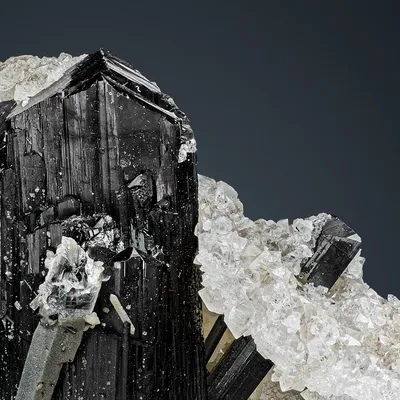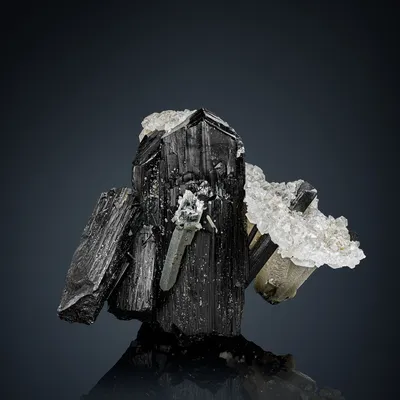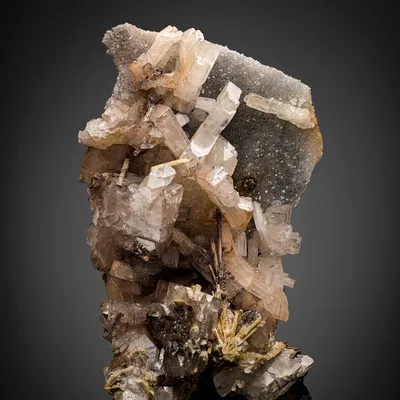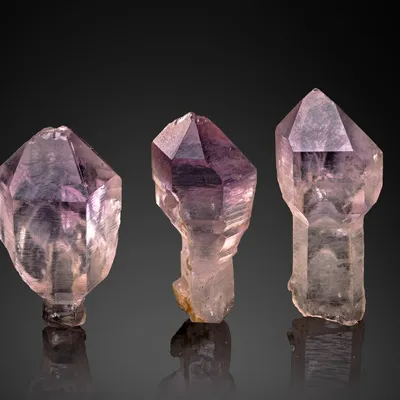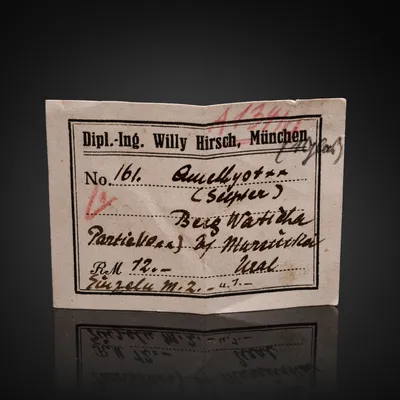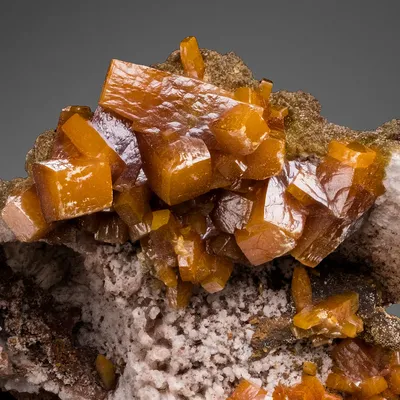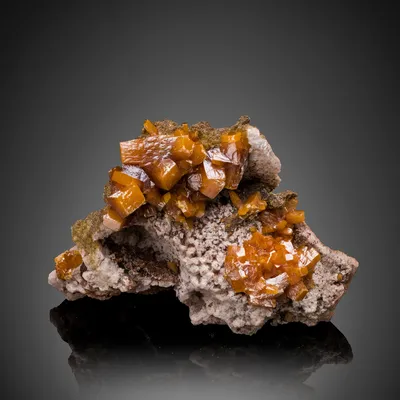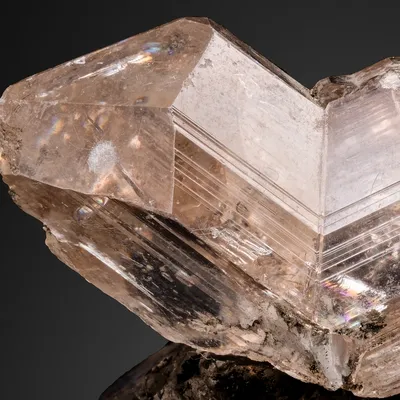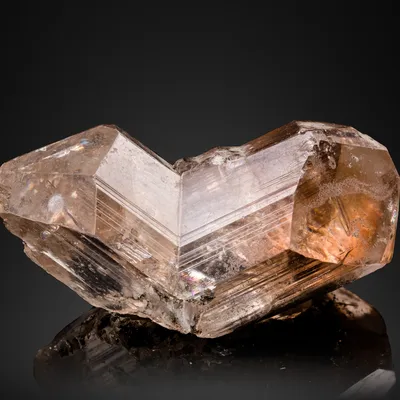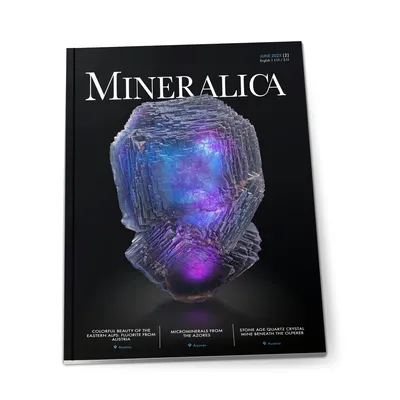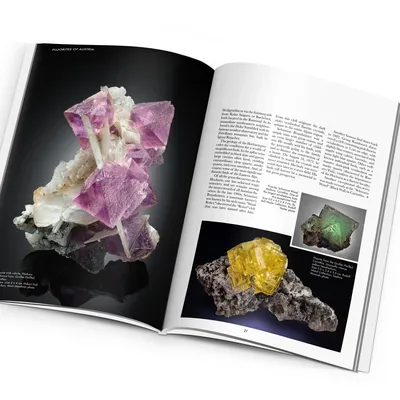Colours of the Earth in cultural epochs and modern ecological trends
A survey of mineral pigments is given along with their availability, occurrences and uses from prehistoric times up to current ecological trends.

Introduction
The extraction and use of red chalk (also known as "red ochre") is one of the earliest human activities and forms of expression. Red chalk has been used as a colorant in Europe since the Palaeolithic; prehistoric red chalk pits can be found, for example, in Poland (Rydno), Germany (Black Forest), Hungary (Lovas) and on the Greek island of Thasos.
A particularly vivid example of the early use of red chalk in Austria is the double burial of newborns in the Krems-Wachtberg area. The two infants were virtually "embalmed" with red chalk and covered with a mammoth shoulder blade. This was particularly conducive to their excellent preservation. The approximately 27,000-year-old find layers (Gravettian) lie at a depth of 5.5 m and were uncovered in 2006 (Einwögerer et al. 2008).
General
According to DIN 55945, the general term colorant is the collective name for all substances that give color. These are divided into three large groups (cf. Raaf 1994):
1. inorganic pigments, natural (e.g. chalk, white) and artificial (e.g. red lead, orange-red);
2. organic pigments, natural and artificial (e.g. indigo, blue) and artificial (e.g. phthalocyanine, blue);
3. organic colorants, natural (e.g. purple) and artificial (e.g. eosin, pink).
The use of mineral pigments in antiquity is described in Pliny (the Elder, 23/24 - 79 AD: Naturae historiarum/Naturalis historiae). Even before him, in the 1st century BC. Marcus Vitruvius Pollio (Vitruvius) provided valuable information on mineral pigments in his ten books on architecture.
The following overview contains a series of inorganic pigment colors that occur naturally as minerals, with special reference to occurrences in Austria. Within a color group, the order is based on the refractive index; colors with high numbers are more opaque. The mineral name (color and/or rock name), chemical formula (not always clear, because mixtures), (n = natural, s = also synthetic), refractive index are indicated.
The main quality characteristics of the pigments are high opacity depending on the refractive index (n), UV resistance ("lightfastness") and good mixability with water or oils (e.g. linseed oil).
Dark brown and black pigments
Brownstone is a collective term for several manganese oxides, e.g. psilomelane, pyrolusite, hollandite) mostly about MnO2 (n, s), the latter a Ba-Mn oxide; these are relatively hard (pyrolusite) to very soft and fine-grained minerals (psilomelane, wad, ...), dark brown to deep black, which mostly occur in weathering horizons of manganese deposits. of manganese deposits.
In Austria there are some areas with Mn deposits (partly former deposits) are known (from W to E, cf. Weber et al. 1997):
In the "Manganese ore district Nordtiroler Limestone Alps" (Schulz 1997), Mn ores occur in the Lias speckled marls of the Allgäu layers (e.g. Davinalpe, Fiechterberg, Walderalm) and the oxide ores of some of them processed the oxide ores into colorants. The situation is geologically similar in the "Manganese ore district of the eastern Limestone Alps" (Götzinger 1997), where the Strubberg layers (Dogger) are mineralized. are mineralized.
Further Mn enrichments are known from the Salzkammergut from the area around Veitsch (Styria), in the Ködnitztal (East Tyrol) and at Poludnig near Hermagor (Carinthia).
In Germany, Ilfeld in the Harz Mountains and Nassau/Lahn are well-known former Mn deposits.
Bone ash and carbon black are mostly amorphous carbon (with organic residues). Bone ash contains apatite as an inorganic component, the soot often consists of fullerenes. With incomplete combustion this colorant is dark grey, with extensive combustion it is light grey. light gray. Colors with these shades of grey were used on Celtic pottery, for example. shades of gray were used on Celtic pottery.
Soot is formed during imperfect combustion and consists of 80-99% carbon, often from fullerenes. Carbon black is widely used today in printer cartridges (printers, copiers, etc.).
Graphite, C (n) 2.0, occurs in the Bohemian Massif in Lower Austria at over 90 locations; (many former mines, Weber et al. 1997), particularly worth mentioning is the former Röhrenbach deposit near Horn is particularly worth mentioning, because here the deposit is (Kleine Taffa) and the graphite has been exposed since the earliest times. time the graphite has been exposed. Accordingly, graphite (of the type Röhrenbach; Fig. 1) was already found in some Neolithic settlements (e.g. Mold and Rosenburg). Mold and Rosenburg).
The "Waldviertel graphites" are often contaminated with (silicate) foreign minerals, which is why they can have a hardness greater than 1 (according to Mohs). From a genetic point of view, these are metamorphic graphite deposits and occurrences of the "colorful series" at the boundary between marble and mica schist (high amphibolite facies); they originated from sapropelite formations (black shales) and are therefore pyrite-bearing.
In the greywacke zone, on the other hand, the graphites were formed from coal (greenschist-facies metamorphic carboniferous coal shales, age approx. 310 million years); the Kaisersberg deposit (Styria) is in operation again today (www.grafit.at), a genetically similar deposit is located near Sunk (Styria).
In Carinthia, a graphite deposit near Klam(m)berg (near Feld am See) was prospected; it occurs in mica schists of the Bundschuh crystalline.
Galena, PbS (n) 4.3, was already used in Egypt as a cosmetic pigment (!); (shiny silver-grey ore mineral). Several small deposits were prospected and mined in the Limestone Pre-Alps of Lower Austria (near Annaberg, Puchenstuben and Türnitz, Lower Austria), significant deposits (former deposits) are located in Carinthia (in the Drauzug a good dozen deposits; the best known in Bleiberg-Kreuth) and several in Styria (in the Paleozoic of Graz).
Together with sphalerite, galena often forms deposits with a worldwide distribution.
Transparent white pigments
These pigments were often used as background colors.
Diatomite (kieselguhr, diatomaceous earth) usually consists of opal. SiO2 H2O 1.43 was extracted in the Oberdürnbach and Parisdorf area near Maissau (Lower Austria) and processed at Limberg (lightweight bricks and insulating compounds).
Gypsum ("calcium white"), CaSO4.2H2O (n, s) 1.52, occurs in many places in the Limestone (Pre)Alps, e.g. at Preinsfeld, Füllenberg, Heiligenkreuz, Mödling (Seegrotte) and Puchberg am Schneeberg (surface mining), as well as in Salzburg (Golling area) and Tyrol (Weißenbach, Reutte). Gypsum is a pigment with a silky white color.
Kaolinite (China-clay), Al4(OH)8(Si4O10) (n) 1.56, was mined near Mallersbach and Niederfladnitz (near Retz, Lower Austria), a current mine is located near Schwertberg, Upper Austria. The white kaolin color remains white even during ceramic firing and burns into the surface.
Talc (talcum, soapstone), Mg3(OH)2(Si4O10) (n) 1.56, is often used as a (dry) lubricant and filler. Currently the only mine in Austria is the Rabenwaldkogel near Anger, Styria, but dozens of small deposits are known in Austria (Tauern slate shell and eastern alpine old crystalline).
Muscovite (mica flour, sericite), KAl2(OH,F)2(AlSi3O10) (n) 1.58, is mostly used as a filler; the only mine in Austria at present is near Aspang (Lower Austria).
Opaque, well-covering, white pigments
These white pigments were often used to lighten ("dilute") paints because only small amounts of them are effective.
Limestone (calcite, calcite, chalk), CaCO3 (n, s) 1.58 ± 0.6; in eastern Austria there are several mines working on pure limestone: e.g. Ernstbrunn, NÖ. (Jura limestone), Mannersdorf, NÖ. (Leithakalk, a red algae limestone - Corallinaceenkalk), Müllendorf near Eisenstadt, Bgld. (chalk, Leithakalk in soft, chalky formation); in Carinthia there is the important marble deposit Gummern near Villach. Today, calcite is the most important white pigment alongside TiO2 (rutile, anatase). When very finely ground (under 2μm)
Calcite/lime/marble gives a well-covering color (also filler in commercial paper). Lime was often used as a base color.
Magnesite, Mg CO3 (n) 1.60, forms coarse white and fine-grained masses of white color in the form of "gelmagnesite". It is an alteration product of serpentinite and therefore only occurs there: e.g. Bohemian Massif (Dobersberg, Pingendorf, etc.) and in the large ultrabasite body of Kraubath (Styria).
Barite (barium sulphate, barite), BaSO4 (n) 1.64, is a relatively inexpensive white pigment and X-ray contrast medium, the only major occurrence in eastern Austria is at Kummerbauerstadel (Semmering area, Lower Austria). ), significant barite deposits are linked to several (former) lead-zinc deposits in Tyrol (Northern Limestone Alps, greywacke zone), Carinthia (Drauzug) and Styria (Graz Paleozoic) (cf. Weber et al. 1997). Barium sulphate is also a component of lithopones.
Sphalerite (zinc sulphide), ZnS (n: mostly brownish, s) 2.37, and secondary Zn minerals (smithonite/zinc spar and hydrozincite) occur in places in the Limestone Pre-Alps together with galena/galena and were mainly mined for brass production (near Annaberg and Türnitz, Lower Austria), but Bleiberg (Carinthia) is also very suitable for white pigments. Lithopone is a (synthetic) precipitation mixture of barium sulphate and zinc sulphide (non-toxic "permanent white", opaque white; for paints and fillers).
Hydrocerussite, Pb3(CO3)2(OH)2, is rarely found as a mineral; however, it was already used in antiquity and was also produced synthetically in large quantities in the Middle Ages and used as a "lead white" undercoat paint. Due to its easy solubility, it is poisonous and led to lead poisoning in some artists. A place name in Wolfsberg (Carinthia) commemorates the production of white lead. In some maps, field names refer to "Bleiweißgrube" (lead white pit); however, it is usually "Bergmilch" (mountain milk) and this is mostly fine-grained calcite (sinter).
Red pigments
Cuprite/red copper ore (copper oxide), Cu2O (n, s) 2.85, occurs in places in the cementation zone of copper deposits, rarely found in Austria.
Cinnabar (cinnabar red, cinnabarite), HgS (n, s) 2.9 ± 0.1, was an expensive import from Slovenia (Idrija; Fig. 2), Spain (Almaden) or Italy (Monte Amiata). Small
occurrences are also found in Austria: rare at the Styrian Erzberg in siderite, several occurrences in Carinthia (near Stockenboi and S Eisenkappel) and in Styria (Gratwein).
In ancient times (especially in the Roman Empire), vermilion was the color of the wealthy citizens (see paintings on the Magdalensberg, Ktn. and elsewhere). The "poorer" had to make do with "red chalk".
Brown, orange, ochre, yellow pigments, iron oxide pigments
Mineralogically, these are hematite (bloodstone) and goethite (limonite) as "pure" minerals or in mixtures with clay minerals and/or manganese oxides. During (reducing) firing, wüstite (FeO, gray to black) and/or magnetite (Fe3O4, black) can also be formed.
Hematite (coarse-grained, iron luster, "iron mica"), Fe2O3 (n) 2.9, is black with a metallic luster in this formation and is used today as a UV-protective paint (Waldenstein mine, Carinthia - MIOX®). Due to its high hardness (6 according to Mohs), it is very difficult to produce fine-grained hematite for pigment purposes ("red chalk") from coarse-grained hematite.
Hematite (fine-grained: English red, polished red, bloodstone), Fe2O3 (n) 2.9, rarely occurs in its fine-grained, often radially radiating formation, but is found in several deposits in the Semmering area (e.g. Grillenberg near Werning and Gasteil near Prigglitz, Lower Austria, Bohnkogel near Altenberg/Rax, Styria); further Styrian occurrences can be found, for example, in the Niederalpl - Rotsohl area, in the Heuberggraben near Mixnitz, Lieschengraben (S-Styria, for color soil); several occurrences are known in Carinthia (except for the Waldenstein type); the "Farbgrübel" near the Kitzbühler Horn (T.) was mined for pigment extraction (cf. Weber et al. 1997). Glass-head-like hematites are known from England (Fig. 3) and from the Erzgebirge (BRD and CZ). These are hydrothermal formations (e.g. the hematite barite formation).
As the streak (the fine powder) of hematite is brown-red (cf. the name bloodstone), it was and is often referred to as "red chalk". It is also one of the oldest mineral pigments in use (see Palaeolithic cave paintings).
"Red chalk" can also be produced by heating goethite/limonite. For example, "burnt sienna" is a mixture of goethite and hematite (FeOOH + Fe2O3).
Goethite (limonite, ochre-yellow + clay), FeOOH (n) 2.1, frequently occurs as a weathering mineral in and above iron deposits of various origins. Due to its wide distribution, it has been used since the earliest times (cave paintings). In addition to the types of deposits mentioned, limonite is also found in many gravel pits (Fig. 4; clay ironstone - often platy, "iron kidneys" - often bulbous). In the Oberpullendorf-Großwarasdorf area (Bgld.) there are extensive deposits that have been mined since the Iron Age, in Roman times and up to the Middle Ages - albeit for iron extraction.
There were many ochre mines for the production of colorants, but only a few are well documented. One is Thal near Graz (Limonit- und Farberdenbergbau Kirchberg, Grazer Bergland,
Styria) as well as Haslau and Hohenrain in the surrounding area (Weber et al. 1997), another is the "Rupa" on the southern side of the Dobratsch (Carinthia; pers. comm. H. Prasnik).
In Europe, large ochre deposits are known above all in Italy (Siena area) and France (Roussilon - the "ochre village"). "Siena raw" is largely limonite (goethite), FeOOH (n) 2.1; secondary constituents are mostly clay minerals. Many baroque buildings have ochre colors ("baroque yellow"), which were given their own names, e.g. "gold ochre", "Schönbrunn yellow", "Seitenstettner yellow".
Jarosite, K2Fe6 (SO4)4(OH)12 (n) approx. 1.55, straw yellow, occurs as a weathering mineral in the graphite deposits of the Bohemian Massif (Fig. 5); it was used in painted ceramics (Lengyel culture) alongside ochre and hematite, and later also in the Middle Ages.
Orpiment (gold pigment), As2S3 (n) 2.8 ± 0.2, was used as a gold substitute (name), a larger deposit is found near Stein/Dellach in the Drau Valley (Carinthia; Fig. 6).
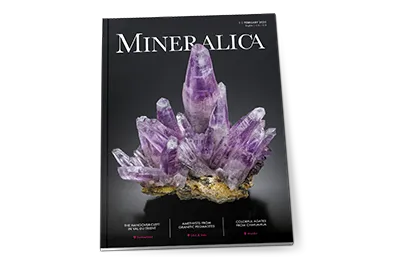
The new premium magazine for mineral collectors
4 issues per year – packed with fascinating finds, expert knowledge, and collector passion. The first bilingual magazine (German/English), including full online access.
Explore subscriptionGreen pigments
Malachite (copper patina), Cu2(OH)2CO3 (n) 1.75, occurs as a common secondary mineral in weathering zones over copper deposits worldwide (in Lower Austria e.g. at
Hirschwang, Trattenbach, Katzelsdorf near Wr. Neustadt; Redlschlag, Bgld., also in Styria, Carinthia and Tyrol; Fig. 7). Malachite was used more as copper ore in the Chalcolithic (Copper Age) (gives very pure copper). However, malachite has also been used since antiquity (Greece, Egypt) for the production of figurines and amulets; the waste was ground into pigment (e.g. for eye shadow, wall paintings).
"Green earths": chromium oxide (eskolaite), glauconite and celadonite
Chromium oxide green (eskolaite, Cr2O3) and chromium oxyhydroxide (CrOOH) are practically only produced artificially for use (mostly ceramics) because natural deposits are far too rare. A well-known use can be found, for example, in Gmundner ceramics ("100 - green-flamed monochrome").
Glauconite and celadonite are rock-forming phyllosilicates, both colored green by bivalent iron; the former tends to be blue-green, the latter "sea-green". The Romans already mined celadonite as a color pigment on Monte Baldo near Verona (later also called "Veronese green"). Glauconite-bearing limestones, marls and sandstones are particularly well known from the Cretaceous period (see also the glauconite quartz sandstones in the flysch zone).
Blue pigments
Blue mineral pigments were and are rare (and expensive: lapis lazuli), which is why blue colors were produced synthetically very early on, e.g. "Egyptian blue", which is also rarely found as the mineral cuprorivaite (CaCu[Si4O10]). It is still produced synthetically today.
Lasurite or lapis lazuli (blue stone) is a framework silicate of the sodalite group with the simplified formula (Na,Ca)8[S2|(AlSiO4)6]. It has a deep blue color that is practically unsurpassed in inorganic nature. In ancient times, only a few deposits were known in what is now Afghanistan. Today, lasurite is also mined in Chile ("Flower of the Andes") and at Lake Baikal (Russia). It often also contains inclusions of golden yellow pyrite, which is an attractive color combination.
Today, the corresponding ultramarine blue (and ultramarine violet) is produced synthetically.
Azurite (azure blue), Cu3(OH)2(CO3)2 (n) 1.7, occurs (more rarely than malachite) as a secondary mineral in weathering zones above copper deposits (e.g. at Hirschwang, Trattenbach, Katzelsdorf near Wr. Neustadt, Lower Austria and elsewhere; Fig. 8). Azurite pigment was extracted on the Buchacher Alpe and used for fresco painting in the chapel of Goderschach (Gailtal, Carinthia) (pers. comm. G. Knobloch).
Azurite has been known and used since ancient times (deposits on Cyprus and in Spain). In the Middle Ages (book illumination) and in modern times, azurite was mined in Hungary and France (Chessy near Lyon). Over time, however, it transforms into green malachite ("greening").
Natural paints, eco paints ...
... are the trend today. "Why natural colors? Because nature offers everything." (see www.natur-farben.ch/naturfarben.php).
However, colorants and solvents must be taken into account! Linseed oil and castor oil are used as slow-drying solvents. However, silicate-based colorants (Na-water glass) are also used, especially in the construction sector.
Almost all of the mineral colorants presented are natural, but some are also toxic: Cu, As, (Cr3+), Cr6+, Pb or carcinogenic (Cr6+).
The "top seller" of the white pigments is the titanium dioxide rutile (TiO2), 2.7 (!). It is chemically stable and occurs naturally in three modifications, with rutile and anatase being more common. Rutile is non-toxic and can be found under the label E 171 as a food additive in toothpaste, chewing gum and cough drops, for example, and as a pigment in cosmetics (see www.auro.de - AURO natural colors).
References
- Einwögerer T., Händel M., Neugebauer-Maresch C., Simon U. & Teschler-Nicola M., 2008: The Gravettian Infant Burials from Krems-Wachtberg, Austria. Babies Reborn: Infant/child burials in pre- and protohistory. B.A.R. S1832, 15–19
- Oxford. DIN 55945: DIN 55945, März 2007. Beschichtungsstoffe und Beschichtungen – Ergänzende Begriffe zu DIN EN ISO 4618 Beuth Verlag GmbH, 2007, 16 S.
- Götzinger M. A., 1997: Manganerzbezirk östliche Kalkalpen. In: Weber et al. 1997, S 353–354.
- Raaf H., 1994: Was enthält was? Lizenzausgabe für Weltbild Verlag GmbH, Augsburg, Herder Verlag GmbH & Co. KG, Freiburg, 310 S.
- Schulz O., 1997: Manganerzbezirk Nordtiroler Kalkalpen.- In: Weber et al. 1997, 353 S.
- Weber L. (Hrsg.) m. Beiträgen von: Cerny I., Ebner F., Eichhorn R., Fettweis G. B. L., Frank W., Göd R., Götzinger M. A., Gräf W., Günther W., Höll R., Kirchner E. C., Köppel V., Mali H., Melcher F., Paar W. H., Prochaska W., Raith J. G., Rantitsch G., Sachsenhofer R. F., Schroll E., Schulz O., Seemann R., Spieler A., Sterk G., Tufar W., Vavtar F., Weiss A., 1997: Handbuch der Lagerstätten der Erze, Industrieminerale und Energierohstoffe Österreichs – Erläuterungen zur Metallogenetischen Karte von Österreich 1:500.000 unter Einbeziehung der Industrieminerale und Energierohstoffe. Arch. f. Lagerst.forsch. Geol. B.-A. 19, 607 S.
- www.seilnacht.com/Lexikon
- http://de.wikipedia.org/wiki/Farbmittel









